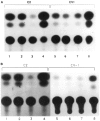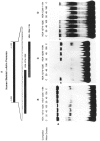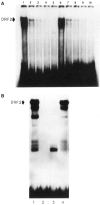The human skeletal alpha-actin gene is regulated by a muscle-specific enhancer that binds three nuclear factors
- PMID: 1633435
- PMCID: PMC6057388
The human skeletal alpha-actin gene is regulated by a muscle-specific enhancer that binds three nuclear factors
Abstract
The tissue-specific distal promoter of the human skeletal alpha-actin gene (-1282 to -708) induces transcription in myogenic cells approximately 10-fold and, with the most proximal promoter domain (-153 to -87), it synergistically increases transcription 100-fold (Muscat and Kedes 1987). We report here that it is a short fragment of the distal promoter, the distal regulatory element (DRE) from -1282 to -1177 that functions as a muscle-specific, composite enhancer. An internal deletion in the DRE (delta -1282/-1151) in the context of the full-length 2000 bp promoter, resulted in a 10-fold reduction in transcription. Three distinct nuclear proteins, DRF-1, DRF-2, and DRF-3, interact specifically with the DRE between positions -1260 and -1193. A site specific mutation that abolishes DRF-2 binding also results in a 10-fold reduction in transcriptional activity. The DRF-2 nuclear protein has characteristics similar to those of the muscle-specific regulatory factor, MEF-2 (Buskin and Hauschka 1989; Gossett et al., 1989). Like the MEF-2 binding site in the muscle creatine kinase enhancer, the critical DRF-2 binding site is also an A/T-rich sequence element. The DRF-2 nuclear protein binds equally well to the MCK MEF-2 binding site and to the A/T-rich regulatory element of the skeletal muscle fast-twitch troponin C gene (Gahlmann and Kedes 1990). Furthermore, this troponin C site competes in vivo for DRF-2 driven expression of the skeletal alpha-actin gene in C2 cells. The DRF-2 site alone, however, does not activate transcription in muscle cells when linked to the SV40 promoter. We conclude that the DRF-2 binding element is a MEF-2 binding site that is required but insufficient for regulation of muscle-specific skeletal alpha-actin gene expression by the DRE. Thus, muscle-specific regulation of the human skeletal alpha-actin gene appears to require interactions between the other elements of the composite DRE enhancer with the protein:DNA complex formed by DRF-2.
Figures










Similar articles
-
A new myocyte-specific enhancer-binding factor that recognizes a conserved element associated with multiple muscle-specific genes.Mol Cell Biol. 1989 Nov;9(11):5022-33. doi: 10.1128/mcb.9.11.5022-5033.1989. Mol Cell Biol. 1989. PMID: 2601707 Free PMC article.
-
The myogenic regulatory circuit that controls cardiac/slow twitch troponin C gene transcription in skeletal muscle involves E-box, MEF-2, and MEF-3 motifs.Gene Expr. 1999;8(4):247-61. Gene Expr. 1999. PMID: 10794526 Free PMC article.
-
A novel myogenic regulatory circuit controls slow/cardiac troponin C gene transcription in skeletal muscle.Mol Cell Biol. 1994 Mar;14(3):1870-85. doi: 10.1128/mcb.14.3.1870-1885.1994. Mol Cell Biol. 1994. PMID: 8114720 Free PMC article.
-
DNA regulatory element cooperation and competition in transcription.BMB Rep. 2024 Dec;57(12):509-520. doi: 10.5483/BMBRep.2024-0069. BMB Rep. 2024. PMID: 39523506 Free PMC article. Review.
-
Nuclear actin and actin-binding proteins in the regulation of transcription and gene expression.FEBS J. 2009 May;276(10):2669-85. doi: 10.1111/j.1742-4658.2009.06986.x. FEBS J. 2009. PMID: 19459931 Free PMC article. Review.
Cited by
-
Tissue-specific expression of the skeletal alpha-actin gene involves sequences that can function independently of MyoD and Id.Gene Expr. 1992;2(3):241-57. Gene Expr. 1992. PMID: 1333317 Free PMC article.
-
Gender-specific potential inhibitory role of Ca2+/calmodulin dependent protein kinase phosphatase (CaMKP) in pressure-overloaded mouse heart.PLoS One. 2014 Mar 7;9(6):e90822. doi: 10.1371/journal.pone.0090822. eCollection 2014. PLoS One. 2014. PMID: 24608696 Free PMC article.
-
Tissue-specific restriction of skeletal muscle troponin C gene expression.Gene Expr. 1993;3(1):11-25. Gene Expr. 1993. PMID: 8508026 Free PMC article.
-
A Mef2 gene that generates a muscle-specific isoform via alternative mRNA splicing.Mol Cell Biol. 1994 Mar;14(3):1647-56. doi: 10.1128/mcb.14.3.1647-1656.1994. Mol Cell Biol. 1994. PMID: 8114702 Free PMC article.
-
The anti-cancer agent distamycin A displaces essential transcription factors and selectively inhibits myogenic differentiation.Mol Cell Biochem. 1997 Apr;169(1-2):61-72. doi: 10.1023/a:1006898812618. Mol Cell Biochem. 1997. PMID: 9089632
References
-
- Bradford M. M. (1976), Anal Biochem 77, 248–254. - PubMed
Publication types
MeSH terms
Substances
LinkOut - more resources
Full Text Sources
Other Literature Sources
Miscellaneous
